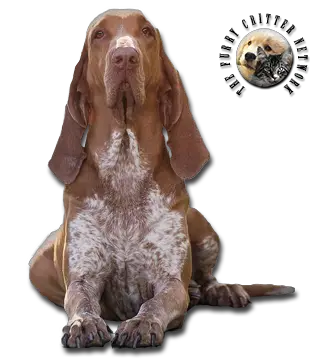Breed Standard
Head: Angular, narrow. Slightly domed skull. Pronounced occipital crest. Slight stop. Straight or slightly curved nosebridge, of the same length as the skull. Very large nose, chestnut to pink or flesh-colored, depending on coat color. Cleanly cut cheeks. Thin lips.
Ears: Long, supple, with slightly rounded tips. Front edge lying against the cheek.
Eyes: Oval, a shade of ocher or brown, depending on coat color.
Body: Can be inscribed inside a square. Powerful neck with slight dewlap. Very pronounced withers. Broad, deep, well let-down chest. Well-curved ribs. Slight tuck-up. Broad, muscular back. Long, broad croup sloping at a 30-degree angle.
Tail: Thick at the base, straight. Carried level to the ground in action. Docked to a length of 15 to 25 cm.
Hair: Short, dense, glossy, finer and lying flatter on the head, ears, feet and backs of the legs.
Coat: White. White with orange or amber spots of varying size and shade. White with chestnut spots of varying size. White with pale orange spots (speckled). White with chestnut spots (chestnut roan). Mask preferably symmetrical.
Size: Dog: 58 to 67 cm. (22.8-26.5 in).Bitch: 55 to 62 cm. (21.7-24.4 in).
Weight: 25 to 40 kg (55-88 lb).
History
Like the Chien d’Oysel, this ancient Italian breed was used in the Middle Ages for netting birds. Fourteenth-century frescoes bear witness to the Italian Pointing Dog’s unquestionable popularity over the centuries. Later, he was adapted to shooting, making him the oldest of the European pointers. All the kings of Europe had an Italian Pointing Dog. The breed was later improved by adding English Pointer blood, making him lighter and faster. Two sub-breeds were developed: the Great Italian Pointing Dog, standing 66 to 70 cm tall at the withers and weighing 35 to 40 kg, and the faster and slimmer Lightweight Italian Pointing Dog (25 to 28 kg). In 1926, these two varieties were grouped under a single standard.
Behavior
This hardy, vigorous dog with a keen nose is skilled at all kinds of hunting. He searches for quarry actively, head held high, at an extended trot. He is a good retriever and adapts easily to family life. He needs firm training.
He needs wide open spaces and lots of exercise, as well as regular brushing and checking of the ears.
Function
Hunting Dog, Companion Dog
Health
Possible health concerns for the Bracco include entropion, hip dysplasia, kidney disease and bloat. Bloat is a health issue to most dogs, being the second largest killer of dogs other than cancer, but Bracco Italian Pointers can be particularly susceptible to it because of their deep chests.






